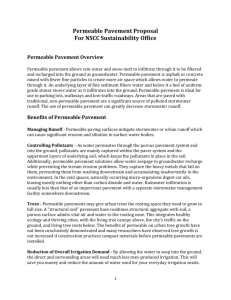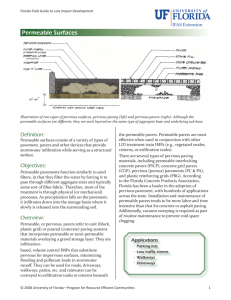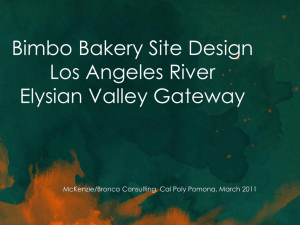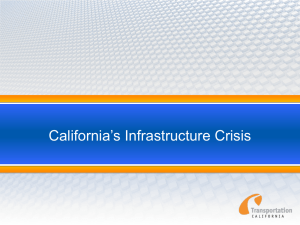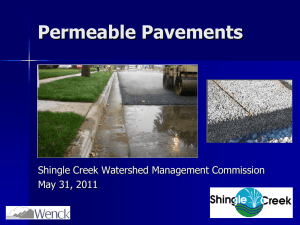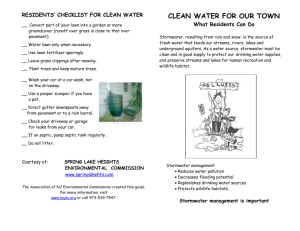X - Low Impact Development Center
advertisement
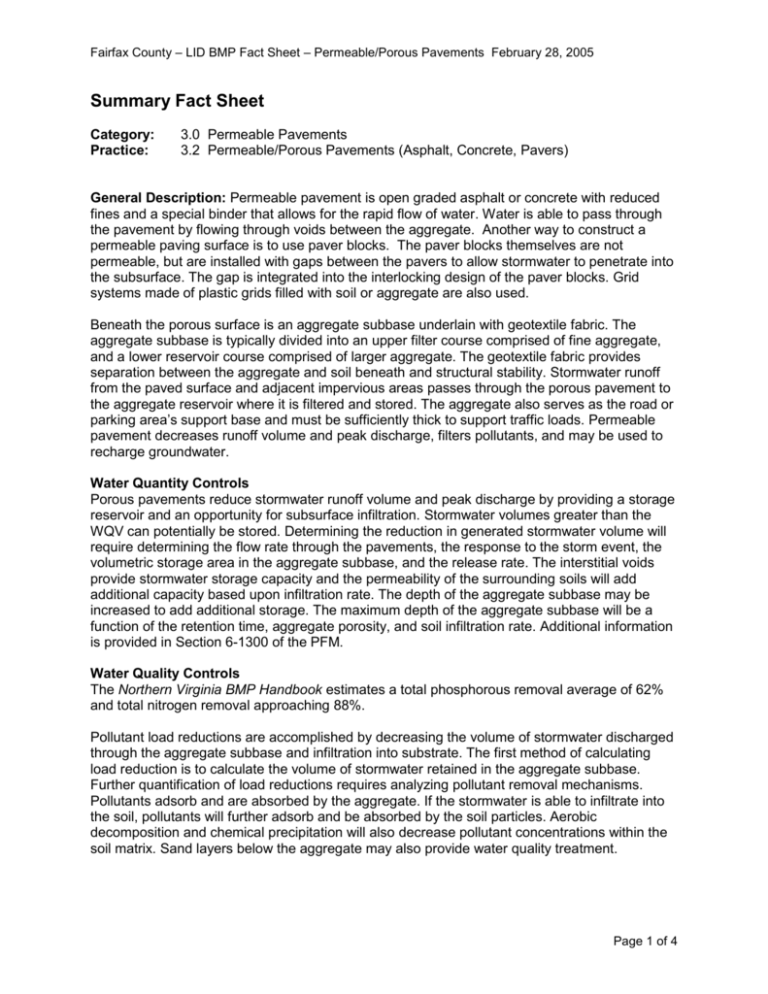
Fairfax County – LID BMP Fact Sheet – Permeable/Porous Pavements February 28, 2005 Summary Fact Sheet Category: Practice: 3.0 Permeable Pavements 3.2 Permeable/Porous Pavements (Asphalt, Concrete, Pavers) General Description: Permeable pavement is open graded asphalt or concrete with reduced fines and a special binder that allows for the rapid flow of water. Water is able to pass through the pavement by flowing through voids between the aggregate. Another way to construct a permeable paving surface is to use paver blocks. The paver blocks themselves are not permeable, but are installed with gaps between the pavers to allow stormwater to penetrate into the subsurface. The gap is integrated into the interlocking design of the paver blocks. Grid systems made of plastic grids filled with soil or aggregate are also used. Beneath the porous surface is an aggregate subbase underlain with geotextile fabric. The aggregate subbase is typically divided into an upper filter course comprised of fine aggregate, and a lower reservoir course comprised of larger aggregate. The geotextile fabric provides separation between the aggregate and soil beneath and structural stability. Stormwater runoff from the paved surface and adjacent impervious areas passes through the porous pavement to the aggregate reservoir where it is filtered and stored. The aggregate also serves as the road or parking area’s support base and must be sufficiently thick to support traffic loads. Permeable pavement decreases runoff volume and peak discharge, filters pollutants, and may be used to recharge groundwater. Water Quantity Controls Porous pavements reduce stormwater runoff volume and peak discharge by providing a storage reservoir and an opportunity for subsurface infiltration. Stormwater volumes greater than the WQV can potentially be stored. Determining the reduction in generated stormwater volume will require determining the flow rate through the pavements, the response to the storm event, the volumetric storage area in the aggregate subbase, and the release rate. The interstitial voids provide stormwater storage capacity and the permeability of the surrounding soils will add additional capacity based upon infiltration rate. The depth of the aggregate subbase may be increased to add additional storage. The maximum depth of the aggregate subbase will be a function of the retention time, aggregate porosity, and soil infiltration rate. Additional information is provided in Section 6-1300 of the PFM. Water Quality Controls The Northern Virginia BMP Handbook estimates a total phosphorous removal average of 62% and total nitrogen removal approaching 88%. Pollutant load reductions are accomplished by decreasing the volume of stormwater discharged through the aggregate subbase and infiltration into substrate. The first method of calculating load reduction is to calculate the volume of stormwater retained in the aggregate subbase. Further quantification of load reductions requires analyzing pollutant removal mechanisms. Pollutants adsorb and are absorbed by the aggregate. If the stormwater is able to infiltrate into the soil, pollutants will further adsorb and be absorbed by the soil particles. Aerobic decomposition and chemical precipitation will also decrease pollutant concentrations within the soil matrix. Sand layers below the aggregate may also provide water quality treatment. Page 1 of 4 Fairfax County – LID BMP Fact Sheet – Permeable/Porous Pavements February 28, 2005 A determination of pollutant load reductions will require an analysis of adsorption and absorption rates for soluble pollutants as well as decomposition and precipitation rates. Reductions in particulates and suspended solids will be achieved by physical removal when filtering through the aggregate. Nitrogen removals depend greatly upon the stormwater infiltrating into the soil where microbial conversion of nitrogen is able to occur. Location: Permeable pavements may be used in many locations where conventional pavements are used, such as parking lots, driveways, and walkways. Areas with the potential for spills, such as gas stations, should be avoided. Permeable pavement should not be used for roadways larger than local residential roads, except possibly on shoulders. Design Construction and Materials: Construction of permeable asphalt and concrete will be similar to that of conventional pavements. Installation of paver blocks may require additional time for placement of the blocks. Similar materials and construction techniques are required for permeable and conventional pavements. The largest difference is the depth of the aggregate subbase and the addition of the geotextile material. Permeable pavement systems typically consist of the following components. Item Unit Estimate unit cost (2005 dollars) Excavation C.Y. $8 - $10 Porous asphalt S.F. $0.50 - $1.00 Porous concrete S.F. $2.00 - $6.50 Concrete paving blocks S.F. $5 - $10 Aggregate C.Y. $30 - $35 Geotextile fabric S.F. $0.70 - $1.00 Perforated underdrains may be used when constructing permeable pavement in areas where soil infiltration rates are low. Observation/cleanout wells should be installed if underdrains are used. A minimum two (2) to four (4) foot clearance must be maintained between the bottom of the infiltration trench and the seasonal high groundwater table or bedrock, depending on site conditions. Preventing overland runoff from entering the parking lot can decrease sediment loading and maximize the performance and lifespan of the pavement. This can be accomplished through the use of a perimeter berm or filter strip. Cost: The cost for permeable pavement to treat runoff from ½ impervious acre is comprised of both the installation cost and annualized costs. These cost calculations were based upon permeable pavement being installed on 10% of a ½ acre parking lot. Permeable pavement is assumed to have a lifespan of 25 years, at which point it will be removed and replaced. Item Installation1 Required Cost per Year (2005 Dollars) 0 1 2 3 4 5 6 7 8 9 10 500 500 500 500 500 500 500 500 500 500 25 12,000 Vacuum Sediment Remove & Replace Total Cost … 12,000 12,000 500 500 500 500 500 500 500 500 500 500 12,000 Page 2 of 4 Fairfax County – LID BMP Fact Sheet – Permeable/Porous Pavements February 28, 2005 Annualized Cost $950 / year (includes replacement in year 25) 1 Developer Cost. Not included in annualized cost. Maintenance: The main goal of the maintenance program is to prevent clogging by fine sediment particles. Vacuum the pavement three (3) to four (4) times per year, depending on the average sediment loading. Do not pressure-wash the pavement, as this may force particles deeper into the pavement material. The application of abrasive materials as a snow treatment should be prohibited in order to prevent clogging. Settlement of paver block systems may require resetting. Cracks and settlement in asphalt or concrete may require cutting and replacing the pavement section. Performance and Inspection: To ensure proper performance, visually inspect that stormwater is infiltrating properly and is not standing on the permeable pavement. Standing water on the permeable pavement may indicate clogging of the open void space. In these instances, vacuuming will be necessary. Routing vacuuming should prevent this from happening, however. If this treatment does not restore permeability, the pavement may be clogged beyond repair and may require replacement. Annual visual inspections should be conducted to check for accumulated sediments. Permeable pavement cross-section Source: Cahill Associates Drainage in both types of pavement Source: Cahill Associates Potential LEED Credits: Primary: Sustainable Sites – Credit 7.1 “Landscape & Exterior Design to Reduce Heat Islands” (1 Point) Sustainable Sites – Credit 6 “Stormwater Management” (1-2 Points) Other: Innovation & Design Process (1-4 Points) Links to Additional Information: Fairfax County PFM: http://www.co.fairfax.va.us/dpwes/publications/pfm/6.htm Virginia Stormwater Management Handbook: http://www.dcr.virginia.gov/sw/stormwat.htm#pubs Page 3 of 4 Fairfax County – LID BMP Fact Sheet – Permeable/Porous Pavements February 28, 2005 Northern Virginia BMP Handbook: http://www.novaregion.org/pdf/NVBMP-Handbook.pdf Page 4 of 4

